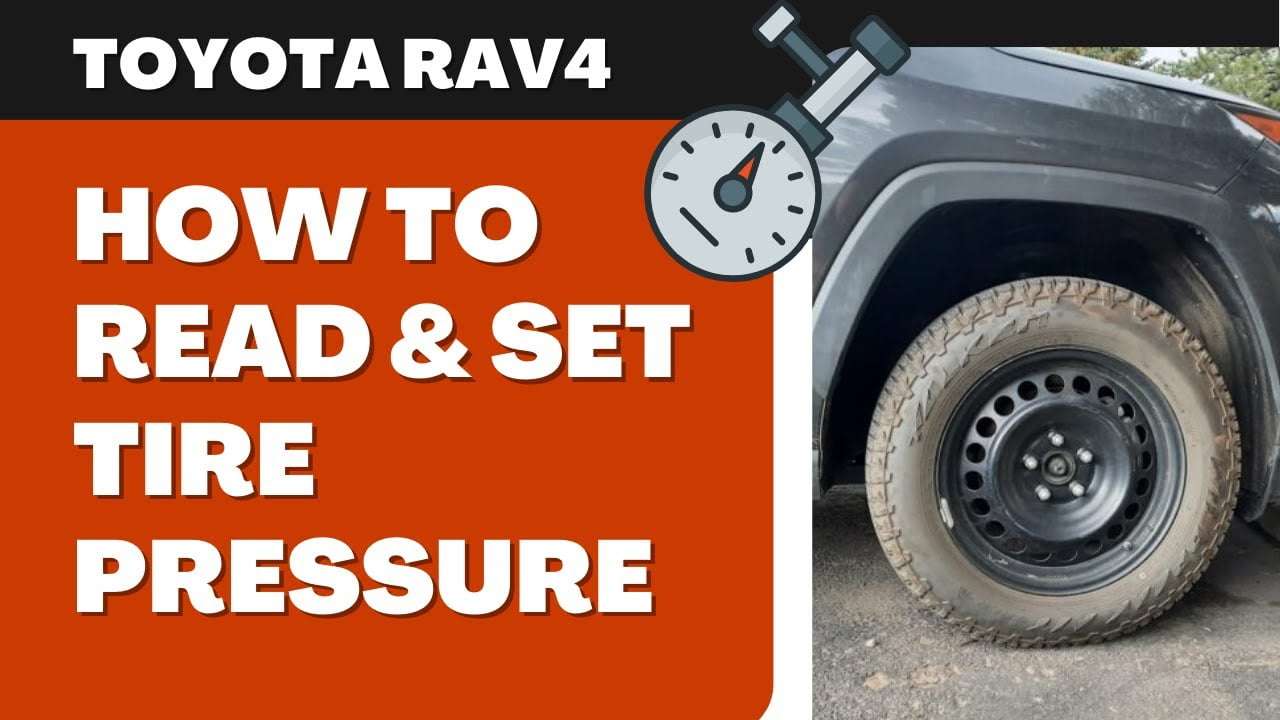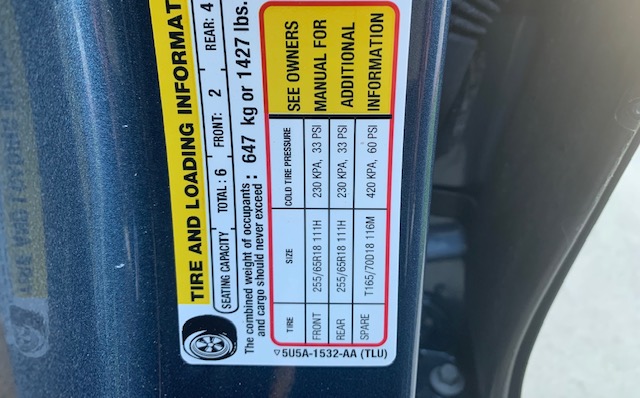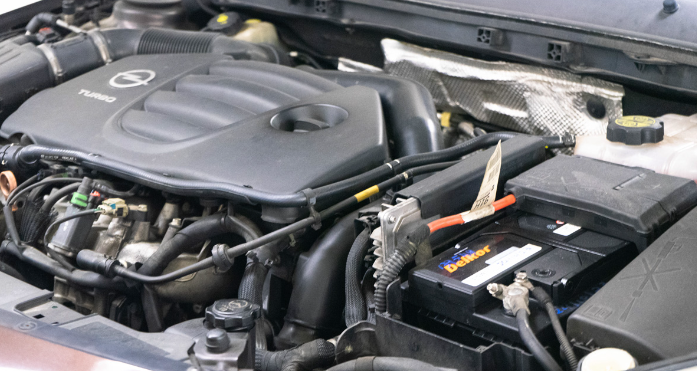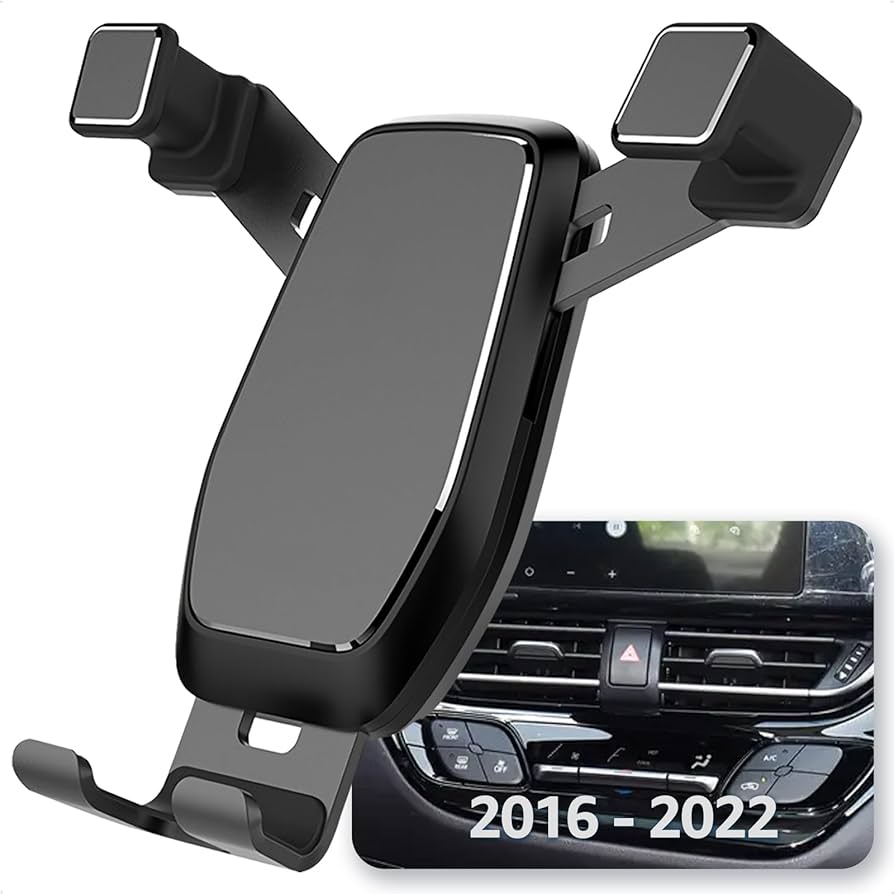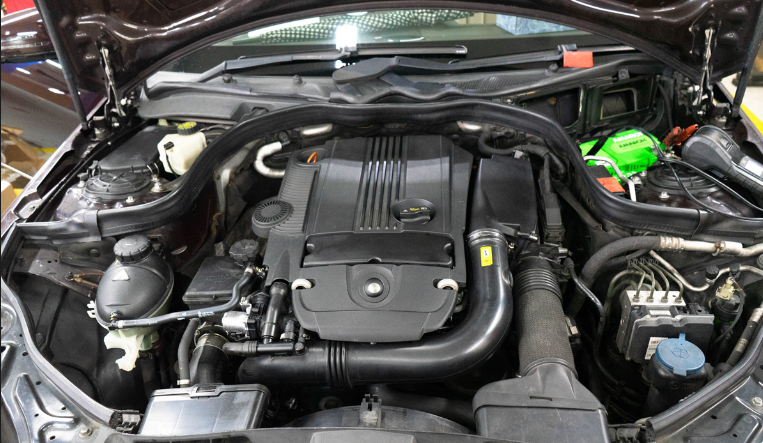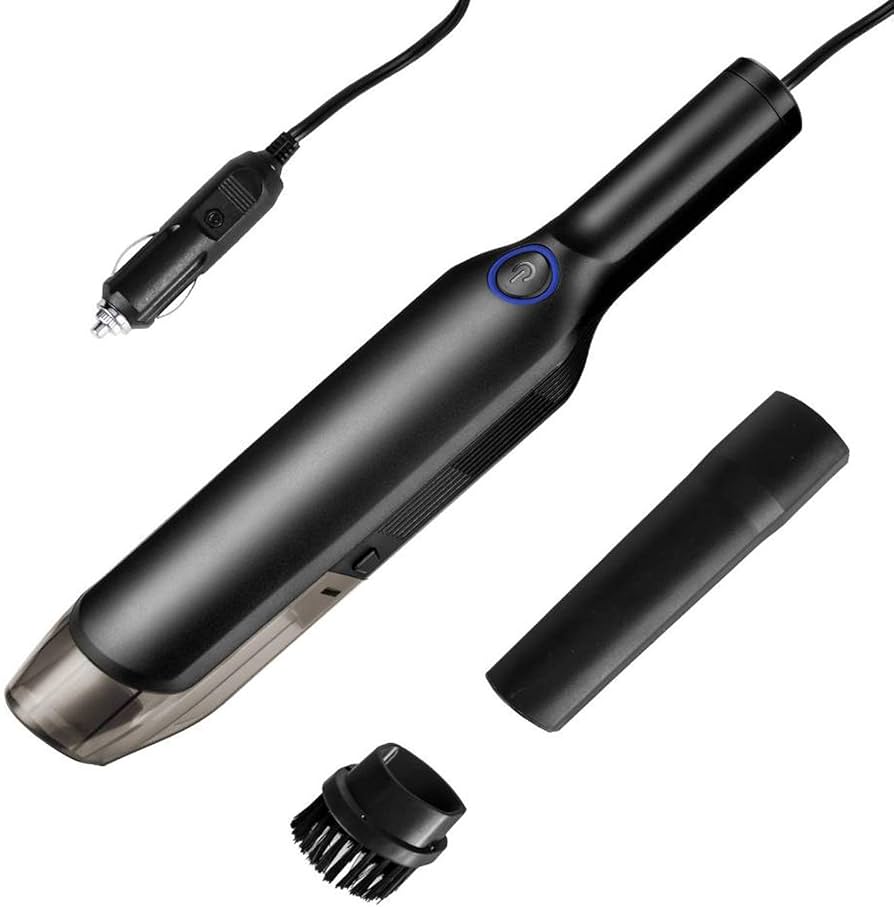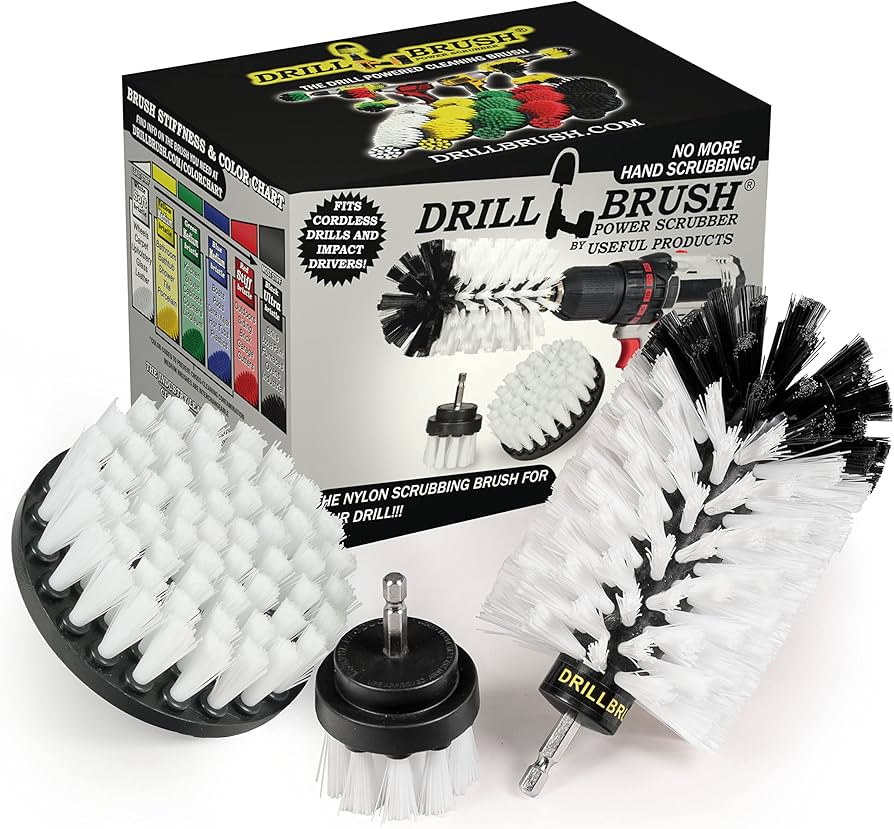To read and set the tire pressure on a Toyota RAV4, check the placard on the driver’s door frame for the recommended pressure, then use a tire gauge to read and adjust each tire accordingly. Ensuring your RAV4 rides smoothly and maintains optimum fuel efficiency starts with proper tire maintenance.
A critical component of this is regularly checking and setting your tire pressure to the manufacturer’s recommended levels.
With the right tools – a reliable tire pressure gauge and possibly a compressor if tires need inflation – you can quickly and easily monitor your tire pressure.
Neglecting this simple task can lead to decreased performance, poor fuel economy, and even safety issues.
Understanding the importance of this routine checkup will help keep your RAV4 in top road-worthy condition, so make it a habit to inspect your tire pressure monthly.
Tire Pressure Management
Maintaining the correct tire pressure in your Toyota RAV4 is vital for optimal driving performance, safety, and fuel efficiency.
This introduction to Tire Pressure Management serves as a guide for Toyota RAV4 owners to better understand and maintain their vehicles’ tire health.
The Importance Of Proper Tire Pressure
Correct tire pressure is a critical factor in vehicle safety, handling, and fuel economy. Over- or under-inflated tires can lead to a variety of issues including:
- Premature tire wear: Incorrect pressure can cause irregular tire wear, reducing the lifespan of your tires.
- Reduced fuel efficiency: Tires not at the right pressure level increase rolling resistance, thus consuming more fuel.
- Compromised handling and braking: Proper inflation helps maintain optimal contact with the road for better control.
- Increase in safety risks: Tires at improper pressures are more prone to blowouts and accidents.
Regularly checking tire pressure and adjusting it according to the manufacturer’s recommendations is essential for prolonging tire life and ensuring a smooth, safe ride.
Tire Pressure Monitoring System (TPMS) In Toyota RAV4
The Toyota RAV4 comes equipped with an advanced Tire Pressure Monitoring System (TPMS) designed to alert you when your tire pressure drops below or rises above the recommended level.
Here is how the TPMS benefits RAV4 drivers:
| TPMS Feature | Benefit |
|---|---|
| Automatic Alerts | Notifies you of significant pressure changes, reducing the need for manual checks. |
| Real-Time Pressure Information | Displays current tire pressures for individual tires, allowing for quick assessments. |
| Enhanced Safety | Prevents accidents by ensuring tires are always within safe pressure ranges. |
| Improved Tire Life | Helps maintain optimal pressure, increasing the lifespan of your tires. |
By monitoring the TPMS alerts and understanding how to check and set the tire pressure on your RAV4, you can maximize vehicle performance and drive with confidence.
Credit: www.reddit.com
Locating The Recommended Tire Pressure For Your RAV4
Maintaining the correct tire pressure in your Toyota RAV4 is essential for safe driving, optimal performance, and fuel efficiency.
The right tire pressure ensures your tires wear evenly and last longer. But how can you be sure you’re inflating your RAV4’s tires to the proper PSI?
Let’s delve into the specifics of locating the accurate tire pressure for your vehicle.
Reading The Tire Information Placard
Your Toyota RAV4 comes equipped with a handy tire information placard located on the driver’s side door jamb.
This label provides all the details you need for tire pressures, including max load ratings and the recommended PSI for both front and rear tires.
Follow these steps to read it:
- Open the driver’s door and look for the placard along the door edge, its frame, or the doorpost (where the door latches when closed).
- Identify the section labeled as Tire Pressure or similar wording.
- Note down the recommended PSI for both the front and rear tires. Remember the RAV4 might have different specifications for each!
Interpreting Tire Pressure Specifications In The Owner’s Manual
For a comprehensive understanding of your RAV4’s tire pressure requirements, the owner’s manual is the go-to resource.
It contains a wealth of information tailored to your specific model and year, including detailed tire pressure guidelines.
To leverage this resource:
- Locate the index section of your owner’s manual, either at the front or the back, and find the page number for tire information.
- Turn to the tire section and scan for pressure recommendations.
- Compare the manual’s info with the tire placard to ensure consistency. It may also provide info for different driving conditions or loads.
Note:
Always double-check the details for your model year, as specifications may vary slightly with each new RAV4 release.
By keeping an eye on your tire pressure and adjusting it as needed, you’ll enjoy a smoother ride and extend the life of your tires.
Step-by-step Guide To Checking Tire Pressure
Ensuring your Toyota RAV4’s tires are inflated to the appropriate pressure is not just a matter of vehicle performance, but also of safety and fuel efficiency.
Regular checks can prevent unexpected incidents and maintain your RAV4’s optimal condition.
Let’s guide you through the process step-by-step.
Gathering The Right Tools: What You’ll Need
Before checking your tire pressure, make sure you have the necessary tools on hand:
- A reliable tire pressure gauge – Digital, dial or pen-type gauges are all suitable.
- Your vehicle’s recommended tire pressure – Found in the owner’s manual or on the driver’s door jamb.
- Air compressor (optional) – For adjustments if the tires are underinflated. Many gas stations offer air pumps.
Checking Cold Tire Pressure: Tips And Best Practices
For the most accurate reading, check your tire pressure when the tires are cold.
This means the car has not been driven for at least three hours or has been driven for less than a mile at moderate speed.
Here’s what to do:
- Remove the valve cap from one of your tires.
- Press the tire gauge onto the valve stem and read the pressure.
- If necessary, inflate or deflate the tire to match the recommended pressure.
- Replace the valve cap securely.
- Repeat these steps for each tire, including the spare.
Best Practices:
- Consistency is key: Check your tire pressure monthly and before long trips or carrying extra loads.
- Remember the spare: It’s just as essential to check the pressure of your spare tire.
- Keep a record: Noting the pressure readings can track tire health over time.
The TPMS Warning Light And What To Do
Your Toyota RAV4 is equipped with a Tire Pressure Monitoring System (TPMS) to alert you when your tire pressure is too low.
If you see the TPMS warning light – a yellow symbol representing a cross-section of a tire with an exclamation mark – it’s time to check your tires.
Following the TPMS Alert:
- Check tire pressure using the steps outlined above.
- Adjust the tire pressure to the correct levels.
- Drive the vehicle to reset the TPMS system. If the light persists, consult your Toyota dealer.
Maintaining proper tire pressure is integral to your Toyota RAV4’s performance. With these steps, you’re equipped to ensure your tires are in peak condition for the road ahead.
Credit: www.rav4world.com
Adjusting Tire Pressure Correctly
Maintaining the correct tire pressure is crucial for the safety and efficiency of your Toyota Rav4. Properly inflated tires ensure optimal grip, reduce wear and enhance fuel efficiency.
Below you’ll find accurate steps to ensure your Rav4’s tires are at their best with the right amount of air pressure.
How To Inflate Your Tires To The Proper Pressure
To inflate your tires correctly:
- Locate the Recommended Tire Pressure: Find the placard on the driver’s side door jamb for the manufacturer’s recommended tire pressure.
- Remove the Valve Cap: Take off the cap from the tire’s valve stem.
- Check the Current Pressure: Use a reliable tire pressure gauge to record the current pressure.
- Use an Air Compressor: Attach the air compressor hose to the valve stem and inflate in short bursts.
- Monitor the Pressure: Frequently check the pressure until the desired level is reached. Use a gauge to avoid overinflation.
- Replace the Valve Cap: Secure the cap back on the valve stem to prevent leaks.
How To Deflate Overinflated Tires Safely
Should you discover an overinflated tire, follow these steps:
- Press the Valve Stem: Depress the pin inside the valve stem using a tire gauge or a similar tool.
- Release Air in Short Bursts: Allow air to escape in short bursts to control deflation.
- Check Pressure Frequently: Use your tire gauge to check the pressure after each burst.
- Stop at the Correct Pressure: Once you reach the manufacturer’s recommended level, cease deflation.
Rechecking Tire Pressure After Adjustment
It’s essential to double-check your tire’s pressure:
- Wait for Tires to Cool: If you’ve been driving, allow the tires to cool for at least three hours before measuring.
- Recheck Pressure: Use your tire gauge to measure the tire pressure once more for accuracy.
- Adjust if Necessary: Inflate or deflate as needed to align with the recommended pressure.
- Ensure Consistency: Ensure that all tires, including the spare, are checked and adjusted to the correct level.
Maintaining Optimal Tire Pressure
Ensuring your Toyota RAV4’s tires are at the correct pressure is crucial for safe driving, fuel efficiency, and prolonging the life of your tires.
Tires that are properly inflated provide the best balance of handling, grip, and wear.
To maintain optimal tire pressure, it’s essential to regularly check your tires and understand the factors that can affect tire pressure such as weather and temperature.
Keep reading to learn how to read and set the tire pressure on your Toyota RAV4 and recognize when professional services might be required.
Routine Checks: How Often You Should Check Your Tires
Checking your tire pressure regularly is the first step in tire maintenance.
For a Toyota RAV4, it’s recommended you perform a tire pressure check at least once a month and before long trips or when carrying an extra load.
Simple and expedient checks can save you from the inconveniences of flat tires and can even help in fuel conservation.
Impact Of Weather And Temperature On Tire Pressure
Temperature changes can significantly affect your tire pressure.
As the weather gets colder, the air inside your tires contracts and the pressure decreases – usually by 1 PSI (pounds per square inch) for every 10°F drop in temperature.
Conversely, during warmer months, tire pressure can increase. To avoid tire wear and ensure safety, adjust the pressure accordingly:
- Check tire pressure during extreme temperature changes.
- Adjust tire pressure during regular maintenance or service intervals.
- Always refer to your vehicle’s owner’s manual for the recommended tire pressure.
When To Seek Professional Tire Services
Professional tire services become necessary when:
- You experience consistent pressure loss and need to identify any punctures or valve issues.
- Your tires show uneven wear patterns, signaling potential alignment or balancing problems.
- The tread depth falls below the legal limit, which may warrant tire replacement.
- You are preparing for a seasonal change and need to switch to appropriate tires.
Professionals can provide accurate diagnostics and services to ensure your Toyota RAV4 maintains its optimal tire pressure and performance.
Remember, maintaining the optimal tire pressure is not only a safety measure but also a way to enhance the performance and longevity of your tires!

Credit: m.youtube.com
Advanced Tips And Troubleshooting
Welcome to our in-depth exploration of tire pressure management for the Toyota RAV4.
In this section, we focus on advanced tips and troubleshooting to ensure your vehicle maintains optimal tire health.
Whether you’re puzzled by persistent TPMS alerts, curious about the consequences of incorrect tire pressure, or considering tire replacement, we’ll guide you through each scenario with expert advice.
Dealing With Persistent Tpms Alerts
If your Toyota RAV4’s Tire Pressure Monitoring System (TPMS) continually alerts you to pressure issues despite correct inflation, consider these steps:
- Reset the TPMS: Sometimes, the system requires a manual reset to recalibrate. Refer to your vehicle’s manual for the proper procedure or press the TPMS reset button located under the dash or in the glove box.
- Check Tire Repair: If you’ve recently had a tire repaired, ensure the work was performed correctly. Poor repairs can cause slow leaks, triggering the TPMS alert.
- Seasonal Changes: Remember that temperature fluctuations can affect tire pressure. Recheck and adjust pressure during extreme weather shifts.
Understanding The Effects Of Over- And Under-inflation
Understanding the consequences of incorrect tire pressure is crucial:
Over-Inflation:
- Leads to a less comfortable ride due to reduced tire surface contact.
- In extreme cases, it increases the risk of a blowout.
- Causes uneven wear, particularly in the center of the tread.
Under-Inflation:
- Results in higher fuel consumption as the engine works harder.
- Increases tire wear on the edges, shortening tire life.
- Might cause poor handling or vehicle sway.
When To Replace Your Tires
Detecting when to replace tires on your Toyota RAV4 is critical for your safety.
Look out for these signs:
| Sign | Indication |
|---|---|
| Tread Wear: | Use a penny to check tread depth. If Lincoln’s head is fully visible, it’s time for new tires. |
| Sidewall Cracks: | Visible cracks on the tire sidewall suggest degradation and possible leaks. |
| Bulges or Blisters: | Weak spots on the tire’s surface are potential failure points. |
| Vibration: | Excessive vibration while driving might indicate tire wear or balance issues. |
Regular checks and understanding the vital role of tire pressure ensure your Toyota RAV4’s tires remain in top condition, offering optimal performance and safety.
Conclusion And Safety Reminders
As we wrap up our guide on tire pressure management for the Toyota RAV4, it’s essential to keep in mind that proper tire maintenance is not just a one-time task.
Continuous monitoring and adjusting of your tire pressure can lead to a safer, more efficient driving experience.
These concluding safety reminders and guidelines will help ensure you keep tire maintenance a top priority.
Summarizing The Key Steps For Tire Pressure Maintenance
- Check tire pressure regularly, preferably once a month and before long trips.
- Use a reliable tire gauge to measure the pressure, ensuring it matches your RAV4’s recommended PSI (pounds per square inch).
- Adjust the tire pressure as needed, inflating or deflating to the correct PSI.
- Always check pressure when tires are “cold” – meaning the vehicle has been parked for at least three hours or has not traveled more than a mile.
- Address the Tire Pressure Warning Light promptly should it activate.
The Role Of Tire Pressure In Vehicle Safety And Efficiency
Maintaining the recommended tire pressure on your Toyota RAV4 has direct implications for vehicle safety and performance.
Properly inflated tires reduce the risk of tire failure and ensure optimum contact with the road, enhancing stability, traction, and braking effectiveness.
When tire pressure is at the proper level, you’ll experience better fuel economy and a smoother ride.
Low tire pressure leads to increased tire wear and can negatively impact the handling and braking of your vehicle, which is crucial to avoid especially in adverse driving conditions.
Let’s keep our journeys safe and efficient by never overlooking tire pressure maintenance.
Tire pressure plays a significant role in your RAV4’s overall performance and longevity.
A commitment to maintaining the correct tire pressure is a commitment to your safety, your passenger’s safety, and the efficiency of your vehicle.
Always refer to your Toyota RAV4 owner’s manual for the recommended tire pressure and adhere to it for optimal vehicle performance.
FAQs: Toyota RAV4 Tire Pressure Monitor
Where Is The Tire Pressure Label On A Toyota Rav4?
The tire pressure label on a Toyota Rav4 is usually located on the driver’s side door jamb. It can also be found in the owner’s manual. The label lists the recommended tire pressure levels for both front and rear tires.
How To Check Tire Pressure On A Rav4?
To check the tire pressure on a Rav4, use a reliable tire gauge. Simply remove the valve cap from one of the tires, press the tire gauge firmly onto the valve, and read the pressure. Repeat this process for all tires, including the spare.
What Is The Ideal Tire Pressure For A Toyota Rav4?
The ideal tire pressure for a Toyota Rav4 typically ranges from 32 to 35 psi. However, consult the tire pressure label or the owner’s manual for the exact recommended pressure for your specific model and tire type.
How Often Should Rav4 Tire Pressure Be Checked?
For safety and performance, check your Rav4 tire pressure at least once a month and before long trips. Tire pressure should be checked when the tires are cold for an accurate reading.
Conclusion
Maintaining the correct tire pressure in your Toyota RAV4 is crucial for safety and efficiency.
By following the simple steps outlined in this post, you can easily read and set your tire pressure. Regular checks will ensure optimal performance and longevity of your tires.
Drive confidently knowing your RAV4 is in top condition.
